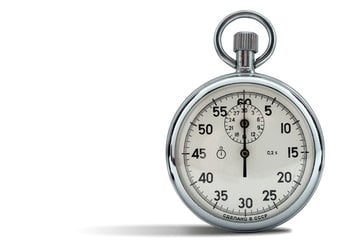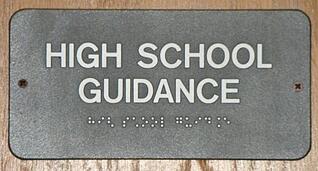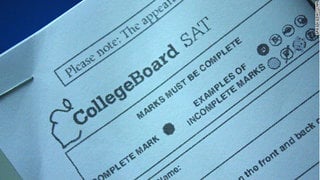
You can slow down the clock with SAT accommodations.
If you have a documented disability, or are just curious about what it takes to get SAT extra time, you may be wondering about the process of getting SAT accommodations. We’ll take you through the process step-by-step, and show you how to maximize your odds of getting accommodations.
If you’re taking the SAT and have a disability or other condition, you will want to read this guide!
Overview of the Accommodations Process
There are two ways to get accommodations on the SAT – either by requesting them through your school, or requesting them yourself using a paper application. College Board strongly encourages going through your school, since they allow school coordinators to use their online Services for Students with Disabilities (SSD) system. If you use the paper request system, it will take longer, plus you will have to provide much more documentation about the accommodations you need and the condition that you have.
Even by going through your school – the fastest option – getting your accommodations can take up to seven weeks. That means if you want accommodations by a certain test date, you should begin the approval process well in advance. For some tests you may even have to begin getting your approval during the previous school year. For example, if you want to take the October SAT with accommodations, College Board recommends you begin the process the previous spring.
Getting accommodations can be a long process, and will require lots of documentation. It should go without saying that you should only seek accommodations if you have a disability or condition that requires them. Typically, most students who get accommodations on the SAT are students with disabilities who also receive accommodations at school.
Still, if you don’t receive accommodations at school but think you may need them for the SAT, read on to learn about the process and your odds of getting accommodated.
The Three Basic Steps to Getting Testing Accommodations
1. Start the process early enough to make sure you have time – keeping in mind it takes seven weeks once your materials are submitted. Keep reading for a detailed timeline!
2. Send your request and documentation to College Board, either through your school’s SSD coordinator or via paper. (For more on documentation, types of accommodations, and conditions that are most commonly accommodated, see below.)
3. Once College Board approves your request, they will give you a seven-digit code. Use that code when signing up for the SAT online and your accommodations will automatically be included.
What Kind of Disability or Condition Do I Need to Have to Qualify?
To get approval of your accommodations by College Board, they need to verify you have a documented disability or condition that impairs your ability to take the SAT.
For the SAT, students with disabilities like the following are often accommodated, though this is not an exhaustive list:
- ADHD
- Autism Spectrum Disorders
- Communication Disorders
- Head Injuries
- Hearing Impairments
- Learning Disorders
- Physical/Medical Disabilities
- Psychiatric Disorders
- Tic Disorders/Tourette’s
- Visual Impairments
Note that limited English proficiency is not considered a condition that College Board can provide accommodations for. For the fine print on College Board’s eligibility standards, see their website.
What If I Have a Temporary Condition?

It’s not going to be easy to bubble in answers with a broken wrist…
If you have a temporary condition that is impairing your ability to take the SAT - for example you broke your right wrist and that’s your writing hand - it is possible to get accommodations, but it will be much more difficult. The odds increase if you are signed up for an AP Exam and will not heal by the late test date, or if you are a senior who hasn’t taken the SAT yet.
The process will be different for you. Instead of working with your school’s SSD coordinator or sending in the Accommodations Approval form to College Board, you will submit a different form, which you can access online here.
What Are Common Accommodations?
The accommodations you can get will vary based on your needs and situation. Here are some of the most commonly given SAT accommodations:
- Extended time (50% extra is most common, anything more than 100% is considered rare) on either one section or the entire test
- Computer for typing essays
- Extra or extended breaks
- Reading/seeing accommodations (e.g. large print, Braille, magnifier)
- Scribe for essays
- Reader for the test
- Different setting – e.g. preferential seating, small group, or a private room
- For a more exhaustive list, see this College Board guide.
As an example, a student with ADHD might take the test with a small group of students to minimize distractions. Or a student with a learning disability in math might receive extended time on the math sections. Or a student with diabetes might request frequent breaks to be able to track their blood sugar during the test.
There are many different potential combinations of condition and accommodation, and they will change based on your particular situation.
Extended time, extra or extended breaks, computers, and reading/seeing accommodations are among the most common, though there is a much longer list of potential accommodations. (The College Board provides a more exhaustive list including rarer accommodations like special time of day and special lighting.) If you need an accommodation not listed, College Board encourages you to submit your request anyway for approval.
Timing to Request SAT Accommodations

Get ready to plan ahead.
Make sure to begin the process of seeking accommodations early. The approval process can take up to seven weeks, and only begins once College Board has received all of your documentation. If some of your documentation is missing and/or you have to resubmit information, the seven-week process will begin all over again. Since preparing documentation and getting all of your information to College Board will take some time, even if you are working through your school, make sure you begin with plenty of time to spare – at least three months before your desired test date to be safe. College Board recommends the following timeline to receiving documentation:
|
2016-17 Test Date |
Deadline for College Board Receiving Documentation |
|
October 1, 2016 SAT |
August 12, 2016 |
|
October 15 and 19, and November 2, 2016 PSAT/NMSQT |
August 30, 2016 |
|
November 5, 2016 SAT |
September 16, 2016 |
|
December 3, 2016 SAT |
October 15, 2016 |
|
January 21, 2017 SAT |
December 2, 2016 |
|
February 21-March 31, 2017, PSAT 10 |
December 16, 2016 |
|
March 11, 2017 SAT |
January 20, 2017 |
|
April 3-14 , 2017, PSAT 10 |
February 13, 2017 |
|
May 1-5, 8-12, 2017, AP Exams |
February 17, 2017 |
|
May 6, 2017 |
March 17, 2017 |
|
June 3, 2017 |
April 14, 2017 |
Timeline via College Board.
Obviously, many of these test dates and deadlines have already passed, but you can use these dates to plan ahead – for example, if you are planning on taking the SAT in October of your junior year, know that you should have all documentation submitted by late August of your junior year.
Also, note that for the October tests, since the deadline for materials being received is in late August – when most school years start – you should begin the process of reaching out to your school’s SSD Coordinator and getting documentation the previous Spring. The first week of school is a hectic time, so you'll likely not be able to get it done then.
In fact, to be safe, it’s not a bad idea to have your materials submitted by June so just in case something is missing, you will have time to get everything sent over the summer so there will be plenty of time to approve your request before the October test.
So How Do I Apply for SAT Accommodations?
Method 1 (Highly Recommended): Go Through Your School
College Board recommends, and we agree, the most efficient way to get accommodations is to go through your school. Specifically, contact your school’s Services for Students with Disabilities (SSD) coordinator. If you’re not sure who that is, contact someone at your school’s guidance counseling department and they will be able to direct you.

Your school’s SSD coordinator will be able to use College Board’s SSD Online service, which is a more streamlined accommodations approval service. In fact, it’s likely your school’s SSD coordinator has already been through this process with other students, so they will be familiar with College Board’s SSD system and will be able to help guide you through the process.
The SSD coordinator will provide you with a parent consent form, which you need to get signed by your parents/guardians and returned to the school before the process can begin. Next, the SSD coordinator will sign up for SSD Online, and submit documentation related to your request, including your IEP (Individualized Education Plan) or 504 Plan if you have one. (If your school’s SSD coordinator is new to the process, direct them to this link for College Board’s instructions.)
In other words, your SSD coordinator will handle most of the process, including making the request and providing necessary documentation. In most cases, this means your family does not have to provide additional documentation.
However, you may need to provide extra documentation if any of the following scenarios apply:
1. You are not on an IEP or 504 Plan, or have one but haven’t been using it for at least the last four months, or haven’t been receiving any accommodations for at least four months. Basically, if you haven’t been receiving accommodations at school, College Board will want to know why you need them for the SAT.
2. Your school does not have documentation that meets College Board guidelines.
3. Your disability testing is not current.
4. You’re requesting an uncommon accommodation like more than 100% extended time. College Board will want to make sure that, when granting exceptional accommodations, you actually need them.
After your SSD Coordinator submits your request, College Board will send back an approval or denial within seven weeks. One benefit of the SSD Online system is that, if College Board requires extra documentation or something is missing, they will be able to immediately alert your school’s SSD coordinator, which will speed up the process.
Method 2: Submit a Paper Request
If you can’t use your school’s SSD coordinator to submit a request, it is also possible to submit a paper request to College Board. This method takes longer, since you are mailing documents rather than sending them online, plus you will have to provide much more documentation.
First of all, to get the form, you either need to pick it up from your school’s SSD Coordinator or request it from College Board’s SSD department, whose contact info is below. There is no way to download it online.
|
|
|
|
Phone |
212-713-8333 |
|
Fax |
886-360-0114 |
|
TTY |
609-882-4118 |
|
|
College Board SSD Program P.O. Box 8060 Mt. Vernon IL 62864-0060 |
Once you get the form, you will list your personal information, your high school’s College Board code, and the date of your desired SAT test. (Note that this form does not double as a test registration form, you will still have to sign up for the SAT after you get your accommodations.)
Next, you will state which accommodations you are requesting. Make sure the accommodations are specifically linked to your disability, and do not repeat. (For example, do not request both a reader and a cassette player if you need the test read aloud.) Also make sure you provide information about those accommodations, including your history of using them at school, and your performance with and without accommodations. (For example, if you are requesting extended time, include a comparison of your work ability in timed and untimed conditions.)
Finally, and most importantly, you will provide documentation about your disability. This includes information about your IEP or 504 Plan if you have one, most recent cognitive or ability testing, and most recent medical evaluation if you have a medical or psychiatric disability.
Documentation required will vary by disability and the accommodation(s) you’re requesting. Your documentation must be very detailed – not just a medical note or your IEP. History of your symptoms, accommodations given in school, and the reason accommodations are necessary for the SAT are all necessary information. You can find more fine print on documentation here.

Okay, so it might not take this much documentation to get SAT accommodations, but it might feel like it!
You can find complete instructions and requirements for completing the paper form at College Board’s website.
Once you send in the form, College Board will first verify that you have sent in all necessary documentation, and request more if needed. After that, they will either approve or deny your request.
Approved?
If your request for accommodations is approved, your accommodations will remain in place until one year after you graduate high school. So once you’re approved, you don’t have to worry about ever going through the process again! College Board will give you a seven-digit code to use whenever you sign up for a test online.
You will be able to use your accommodations on all College Board tests, including the PSAT, SAT, SAT Subject Tests, and AP Exams. To use them on SAT and SAT Subject Tests, use your code when you sign up online. For the PSAT and AP Exams, inform your school you receive accommodations from College Board and they will make sure your accommodations are in place on test days.
If you have to change your accommodations, either inform your school’s SSD Coordinator and have them submit the request through SSD Online, or submit your request independently. Again, the fastest way to change your accommodations will be by going through SSD Online, so use that if possible.
More Hints and Tips
If you need accommodations, get them as early as possible in your high school career. Since College Board’s accommodations will last until after you graduate, the earlier you get your accommodations the more you will be able to use them – especially on AP Exams and the PSAT, which you may begin taking as a sophomore or even a freshman.
If you’re unsure if you need or want accommodations on the SAT, consider your situation. If you’re on an IEP or 504 Plan that grants you extra time, breaks, or tools on tests, it’s highly likely you will also benefit from those accommodations on the SAT. Remember, the SAT is a very challenging test that requires a ton of mental processing, math calculations, and writing in a short period of time. Plus, it will be easier to get accommodations on the SAT if they are similar to ones you have been using in school.
If you are not on an IEP or 504 Plan at school, but have a condition that will make the SAT difficult, consult with your school’s SSD Coordinator about taking the SAT with or without accommodations. It will be harder – though not impossible – to get accommodations if you are not on a plan with your school, so determining if you need them will be an important first step.
You could also try taking SAT Practice Tests with and without the accommodations you think you will need to get a sense of if you want to request them. For example, if you think you will need extra time, try taking one practice test using typical SAT timing, and one with extended time. If your condition or disability makes it markedly more difficult to complete the SAT in the allotted time, consider seeking out the accommodation.

Finally, whether you end up getting accommodations or not, make sure you take enough time to study and prepare for the SAT. It is a very difficult test, and will not be like tests you take for class or standardized state exams. Along with your necessary accommodations, smart studying is the best way to be ready for the SAT.
What’s Next?
Once you get your accommodations, what score should you aim for? Learn about the average SAT score, the average SAT score in your state, and how to develop your own personal target score.
Curious about how the SAT is scored? Learn how your answers get turned into a composite score between 600 and 2400 and how to use that information to your advantage.
Stressed about taking the SAT? Learn about the three most common sources of anxiety and how to cope with them.
Want to improve your SAT score by 160 points? We've written a guide about the top 5 strategies you must be using to have a shot at improving your score. Download it for free now:
Have friends who also need help with test prep? Share this article!

Halle Edwards graduated from Stanford University with honors. In high school, she earned 99th percentile ACT scores as well as 99th percentile scores on SAT subject tests. She also took nine AP classes, earning a perfect score of 5 on seven AP tests. As a graduate of a large public high school who tackled the college admission process largely on her own, she is passionate about helping high school students from different backgrounds get the knowledge they need to be successful in the college admissions process.


































 Holly R.
Holly R.